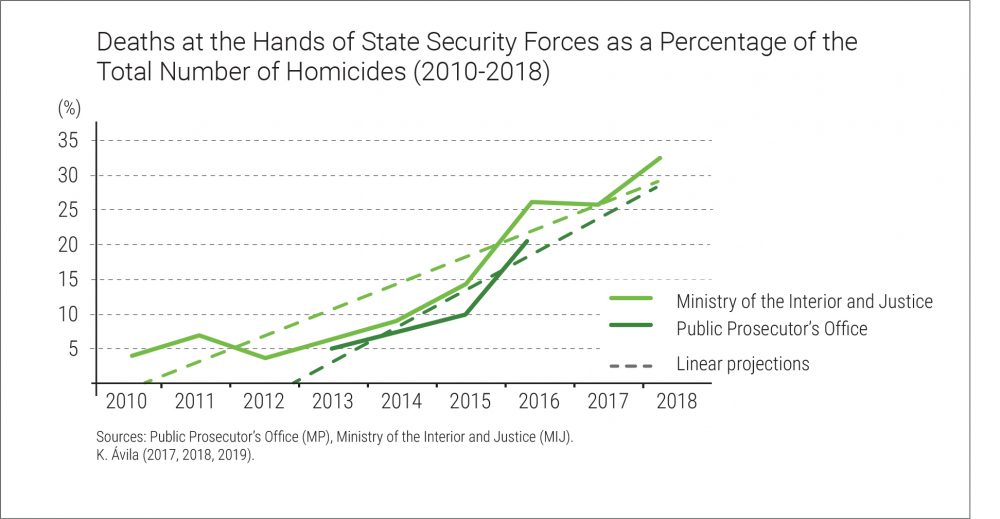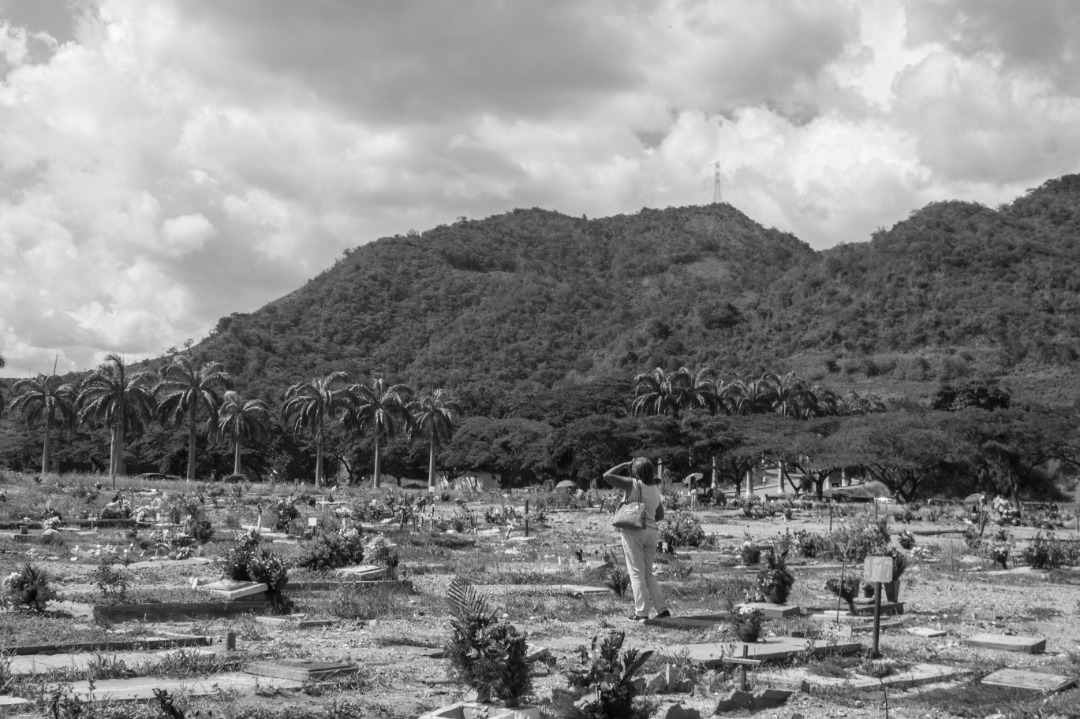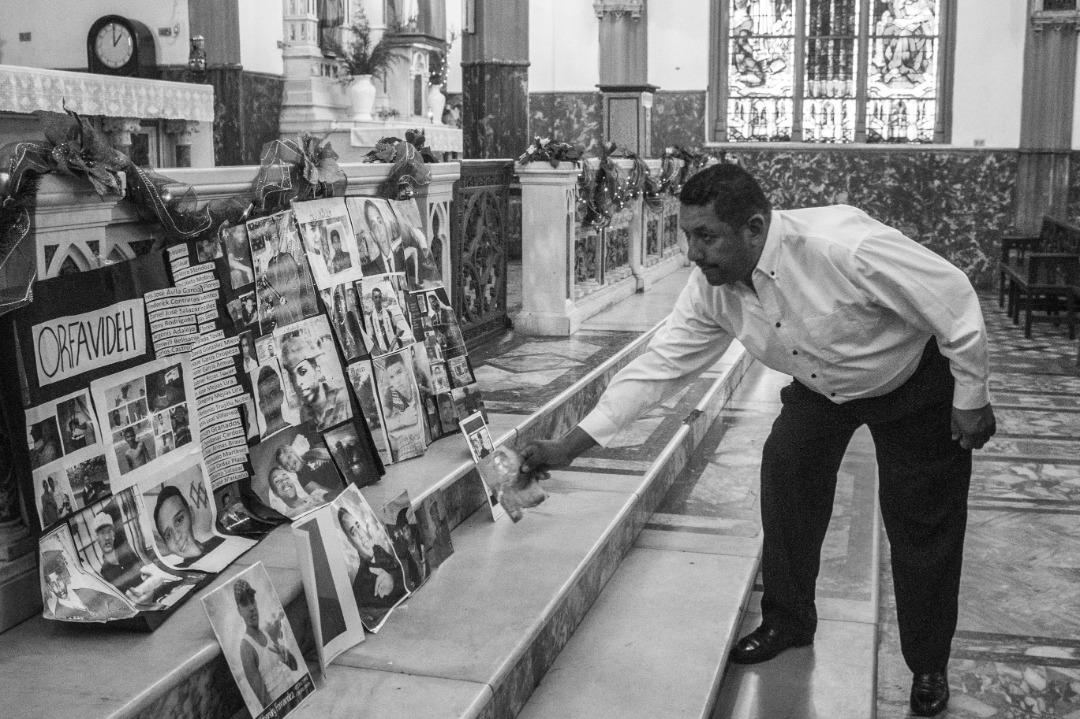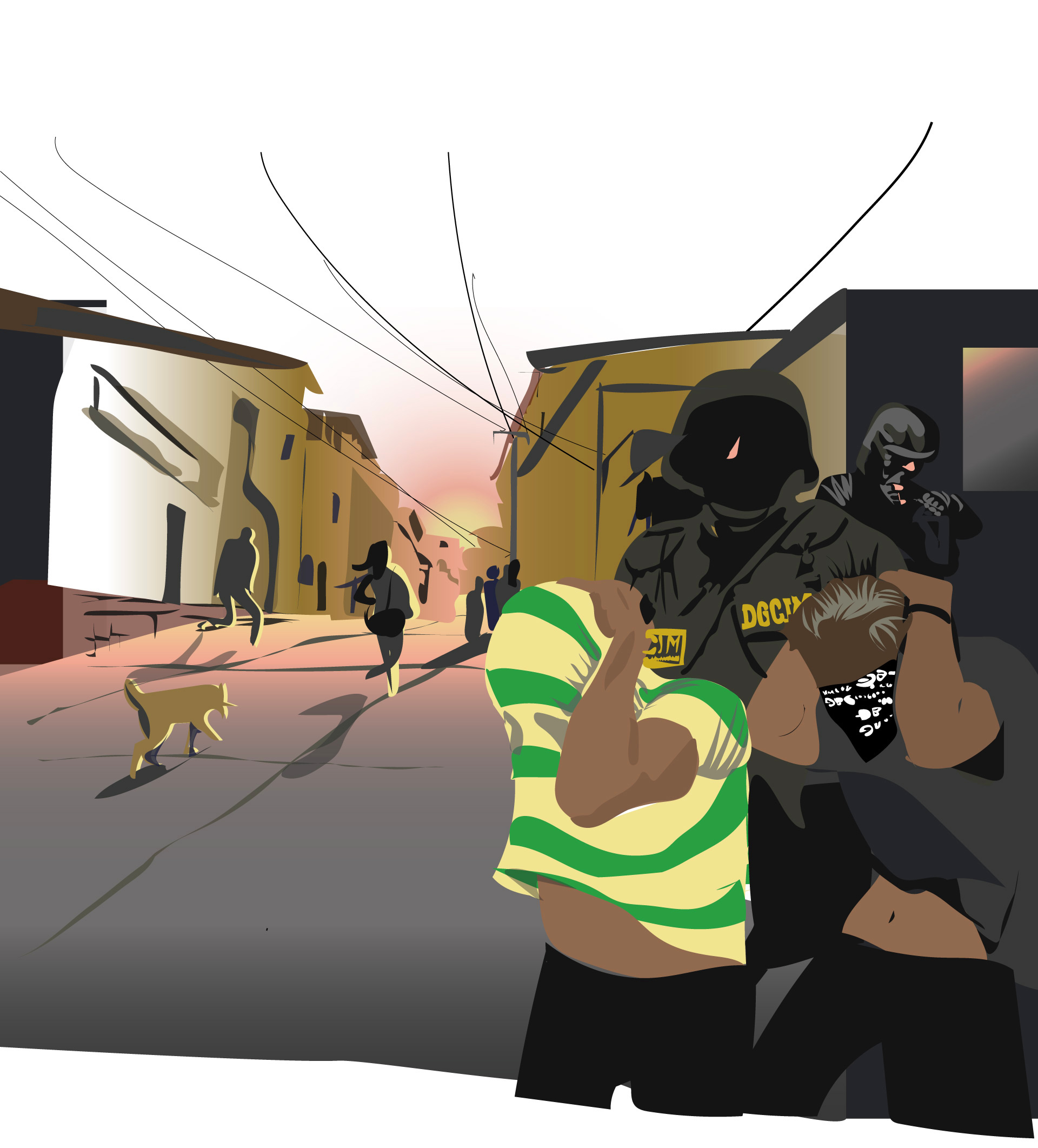Interview with Keymer Ávila, conducted by Fabrice Andréani
What is the current state of relations between security forces and the Venezuelan population, especially the working class?
Historically, Venezuelan security forces have been known for their militarization, their partisan politicization, and their excessive violence against the working class. The warfare tactics used against various left-wing guerrillas in the 1960s and 1970s,[mfn]The guerrillas emerged out of the Communist Party (PCV) and other left-wing parties and were backed by Cuba. They sought to end the domination of the Social-Democratic (AD) and Christian-Democratic (COPEI) parties, which alternated in office since the 1958 democratization.[/mfn] resulting in thousands of cases of human rights violations, were incorporated over the following decades into ordinary law enforcement practices. In February 1989, military and police repression of the Caracazo popular protests against neoliberal reforms resulted in 500 to 3000 deaths, according to local and international NGOs. It represented a point of no return.
The country entered the 21st century with a pledge to permanently break with a delegitimized political system that excluded and criminalized the working class. But in spite of a few changes to the law and in public discourse, the violence perpetrated by security forces has actually become more frequent and deadly across the past decade, especially from 2013 onwards, with major peaks in 2015, 2016 and 2018. This trend was accompanied by a considerable deterioration in economic and social conditions, as well as by the government’s loss of legitimacy, generalizing institutional violence against the backdrop of an overall regression of civil and social rights.

The table above shows a significant increase in the number of victims killed by state security forces between 2010 and 2018, the period for which official figures are considered to be most reliable. Out of 23,688 deaths recorded over eight years, 69% occurred between 2016 and 2018, while the number of deaths caused by security forces rose by 622% between 2010 and 2018, from 2.3 to 16.6 per 100,000 inhabitants. That rate is higher than the overall homicide rate of most countries in the world (6.1 per 100,000 on average).
Over the same period of time, the share of those killings in the overall homicide rate, which is itself one of the highest in the world (estimated to be between 50 and 70 per 100,000 inhabitants), likewise surged from 4% to 33%. At present, one out of every three homicides is attributed to the intervention of state officials.

This type of homicide is nearly four times less frequent in Brazil, where it represents 7% of total homicides, and more than three times less frequent in the United States, where it accounts for between 8 and 10%. In 2017, there were more such cases in Venezuela (4998) than in its neighbor to the south (4670), even though Brazil has seven times as many inhabitants.
I regularly monitored and cross-referenced cases mentioned in the press, in addition to reviewing official and independent victimization reports, the extensive research conducted by my peers, and the testimony of victims’ families and neighbors. My work demonstrates that the people killed during security interventions were almost exclusively poor, racialized (morenos, or dark-skinned) young men living in the barrios (working-class districts). The government’s version of events, which is disseminated via state media and other sources, legitimizes those homicides by portraying the victims as criminals who “died during a confrontation with the police”.
But on closer examination, it appears that such confrontations actually represent a minority of cases; they could even be termed the exception. Even setting aside evidence from the numerous eyewitness accounts, the official death toll for these “confrontations” reveals a highly problematic situation in terms of academic knowledge as well as of international standards on the use of lethal force by the state. The use of lethal force is generally considered abusive and disproportionate when the civilian death toll is ten times higher than the number of fatalities among state agents. Here, however, the civilian mortality rate is ninety-four times higher. The same official figures also estimate the number of fatalities to be sixteen times as high as the number of injured, and the number of fatal outcomes to be five times as high as the number of arrests. In other words, given all of the information available, it seems that the use of lethal force is intentionally excessive most of the time, and often rises to the level of extrajudicial killings.
In the early years of Chavismo, a number of vocal critics of the violence perpetrated by state security forces, particularly in the working-class districts, were drawn to that political movement. Has nothing been accomplished since?
Since achieving independence, Venezuela has always lacked a unified institutional police system. As a rule, police agencies were poorly regulated and excessively militarized, with little legitimacy in the eyes of the public. In addition, they were scattered across the country, and many of them acted as private militias on the regional and local levels, serving the interests of the political potentates of the time. Due to legal gaps and procedural fragmentation, a lack of coherence, symmetry, and coordination between units had become the norm, together with financial and career-related uncertainty. During Hugo Chávez’s reelection campaign in 2006, following a series of scandals implicating police in several cases of kidnapping and murder, the government declared its intention to come to grips with the problem. By creating the National Commission for Police Reform (CONAREPOL), Chávez found a clever and credible way to channel the security-related grievances that his opponents had placed in the public spotlight.
For three years, the CONAREPOL represented a pluralistic, inter-institutional workplace, in which technical and academic input was mobilized to create a police force based on the protection of human rights, the professionalization of civil servants, and the civilian nature of the institution. This work consisted of three parts: a detailed diagnosis of problems in the police force at the national, regional and city levels; the constitution of a police force that would be more attuned to the country’s social, cultural and political circumstances; and recommendations to enable increased oversight of police management by citizens. The initiative relied on large-scale public consultations and systematic surveys, which generated a solid foundation of evidence and legitimized the entire process, while hinting at a more general change in public policy.
The CONAREPOL led to the adoption of the Law on Police Service (2009), which provided a model for a civilian, preventive, professional police force that would uphold human rights. It also aimed to harmonize the various police agencies and to create a national police service. Since 1937, this function had been de facto fulfilled by the National Guard, a military corps, whose members often headed municipal and regional police units.
However, despite its indisputable contributions to Venezuelan law and public policy, the ideal represented by the CONAREPOL was not implemented in actual institutional practices. In fact, the work of the Commission allowed the government to use the “new model” to restore the reputation of police institutions whenever their legitimacy was called into question. But the government instead permitted – and even encouraged through its directives – a counter-reform movement to develop on the ground. The reform became a rhetorical ritual obscuring ordinary police practices, which in turn became all the more dangerous and harmful.
One of the results of this paradoxical process was the development of police hypertrophy, i.e., the accelerated and disproportionate growth of the police institution. Instead of creating sensible change based on frequent assessment, the CONAREPOL has been used as a pretext to significantly expand the police force at every political and administrative level (national, regional, municipal) – the very opposite of what the Commission had recommended. From 2006 to 2017, the total number of police officers rose from around 115,000 to 175,000 (a 53% increase), and the number of police officers per 100,000 inhabitants increased from 429 to 557 (207 higher than the international average of 350). This is a clear indication of the emergence of a police state.

Moreover, the considerable increase in the number of police officers has been coupled with the utmost disregard for recruitment and training standards, thus further undermining the subsequent oversight and evaluation of those new armed recruits, who are sent out onto the streets after undergoing hasty training. These officers then lay down their own law outside of any legal or institutional framework,[mfn]The general impunity rate was estimated at over 90% – in spite of high incarceration rates for minor offenses and occasional displays of “efficiency” for victims coming from a privileged background –, but that rate is even higher for police officers and servicemen.[/mfn] calling into question the true role of police in Venezuela. There is no doubt that the current homicide rates, both overall and due to state agents, can largely be attributed to police hypertrophy.[mfn]Police hypertrophy also leads to the fragmentation of security forces, which are divided into various factionspursuing their own (and eventually illegal) agendas, often clashing with each other: in 2016, 19% of police officers who were shot dead were killed by a fellow police officer (27% in the Caracas area).[/mfn]
These changes accompanied the continued militarization of social and political life. The militarization of security forces is nothing new, but it is still worth pointing out that of the past fifteen Ministers of the Interior, twelve were former military officials. And beyond the appointment of military officers in various sectors of government, this trend has also affected the professional culture and practices of civil servants in general, including civilians, and especially police officers, who have developed an essentially belligerent, predatory attitude toward the civilian population. Over the years, this has led to increasingly systematic, brutal, and militarized police operations, such as the Operations for the Liberation of the People (OLP), which were launched in 2015, or those conducted today by the Special Actions Forces of the Bolivarian National Police (FAES in Spanish). This situation is the direct antithesis of the CONAREPOL model.
How is this institutional violence distributed across the social space?
The issue of repression and institutional violence in Venezuela has often lent itself to partisan interpretation. Many traditional media outlets, representing capitalist interests and reflecting racial and class prejudices, tend to paint all victims of violence with the same brush. In doing so, they create confusion around an already critical situation. Indeed, the thousands of victims mentioned above are poor, racialized young men, who lived in the barrios and have been annihilated under the pretext of “public security.” They do not appear to be dissidents or protesters. This is not to say that the repression of protests is not brutal, but the use of lethal force in those cases is by no means as massive or systematic as in daily security operations in working-class districts.

Moreover, when poor residents of working-class districts take to the streets in protest, the repression they face is much more violent than that inflicted on students or young people from the middle class. This inequity was obvious in January 2019, when nearly 60 people died in less than two weeks. To some extent, from the state’s point of view, the massacre of poor people in the name of “security” served as a practice run for the use of state violence against sectors with greater social, political and media capital. While these sectors showed relative tolerance or even support for militarized operations in the barrios in 2015 and 2016, they were eventually subjected to unprecedented levels of violence during the 2017 large-scale protests.
This being said, to deter middle- and upper-class protesters, the government generally prefers to rely on theoretically non-lethal but equally abusive and violent means, such as police searches, arbitrary arrests and detentions, military tribunals, torture, and destruction of and damage to personal property. Such practices illustrate what Achille Mbembe calls the “infrastructure war”,[mfn]A. Mbembé, “Necropolitics”, Public Culture, 2003, n°15, pp. 11-40.[/mfn] in which public officers resort to looting and predation, stealing valuable items – money, jewelry, electronics, clothing, or even food. Of course, this type of institutional looting is also used against the poor, but in the case of middle-class protesters, it does not end with the destruction of their homes and the execution of their relatives.
These war tactics are also applied against the most visible and influential opponents of the government, including mayors and deputies. Together with PROVEA, an NGO, we calculated that in 2018 alone, politically motivated arrests increased by 574% compared to the average over the past decade. Additionally, at least five political prisoners have died in prison since 2015.
Moreover, not only has the repression of the opposition become largely normalized – with bans on running for election, arrests for “violence” or “conspiracy” (whether real or alleged), and forced exile – but the government also considers dissidence or disaffiliation among civil servants to be acts of high treason punishable by long prison sentences or else exile. The most emblematic cases include the exile of the former Public Prosecutor in the summer of 2017, and the imprisonment of two former ministers: Hugo Chávez’s former Defense Minister in 2008 and Maduro’s former Interior and Justice Minister in 2018 – both remain to this day in prison.
Finally, concerning broader policing practices, the government has used an extensive range of disciplinary tools in order to target the poorest groups of the population. For instance, the “Homeland card” provides access to basic goods and services, and CLAP (Spanish acronym for Local Supply and Production Committees) packages contain subsidized food products that are often sorely needed in light of chronic shortages and hyperinflation. The Homeland card and CLAP packages are powerful means of political and social control. They led to the denunciation and extortion of protesters in many barrios in early 2019, spreading terror in communities and destroying the ties of solidarity and fraternity between neighbors.
How are those inequalities on the ground echoed in the media?
The difference in media coverage of the daily deaths of young people in the barrios versus those of young protesters is very telling. In both cases, the victims are killed by state agents for clearly political reasons, but their portrayal in the media is largely determined by racial, class, ideological and political biases.
To describe the first category of deaths, those that take place in the barrios, I use the term slow-drip massacre. These homicides do not make national headlines; they are not used as rallying cries by opposition parties, or by most NGOs and international human rights defense organizations. They are the faceless, nameless dead. Their relatives have no space in which to express themselves, and no significant support network. Victims are labeled “criminals” after their deaths in order to justify their murders. But the message is clear: the state can kill the poor with total impunity. And this rationale can very well be applied to other groups of the population if need be…
The second category of deaths, those of young protesters, tends to be more sporadic and selective. These generally include young middle-class students or unionized workers, affiliated in one way or another with an institution of greater organizational capacity. Those victims are used by political parties in their campaigns; they make headlines and are prioritized by local human rights NGOs and their transnational partners, so that victims are transformed into hero-martyrs. This undoubtedly affects the institutional response to this type of event, as well as the actual and perceived costs of state violence.
Further Readings:
- Keymer Ávila. ¿Qué pasó con la reforma policial en Venezuela? Preguntas y respuestas básicas sobre el proceso en su etapa púber. Friedrich Ebert Stiftung (FES), 2019.
- Monitor del uso de la fuerza letal en América Latina. Un estudio comparativo de Brasil, Colombia, El Salvador, México y Venezuela. CIDE/LAV/FIP/IUJ/FBSP, 2019.
- Situación de los Derechos Humanos en Venezuela. Derecho a la Libertad Personal. Informe Anual 2018, PROVEA, 2019.

